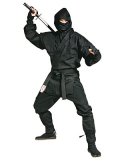N is for Ninja – In the media, ninja are everywhere. What martial arts movie would be complete without a ninja? But the truth is that much of what we in the West think of ninja is based on myths, legends, and flat-out lies. So to educate those who feed most on the ninja mystique (i.e. martials arts, superhero, and sci-fi fans)
Myth 1: Ninja were called ninja. – During the fourteenth century, it’s generally accepted that the covert assassins and saboteurs we now call “ninja” came into existence. However, during this period of time, they were never called “ninja.” In fact, they weren’t called anything at all, because they weren’t really recognized as a unique or elite group. It was only in the fifteenth century that this activity came to be considered a defined group of people, and the word “shinobi-no-momo” came to be applied to them. “Shinobi” means “to steal away” as in acts of stealth, and “momo” refers to a person. The written characters used to portray “shinobi” can also be pronounced “nin-sha,” which evolved into “ninja,” which became popular among Westerners after World War II because it’s easier to pronounce.
Myth 2: Ninja were an elite and highly specialized group of trained agents. The ninja are synonymous with an image of highly skilled and expert warriors that are immediately identifiable. In reality, the art of ninjitsu was developed over time. In the fourteenth century, acts of sabotage and assassination were considered dishonorable in Japanese culture, so the ninja evolved as a loose collection of people willing to commit disreputable acts. In other words, outcasts and thugs. But even then, there was no formalized training for ninja – they were kind of making it up as they went along. It wasn’t until the seventeenth and eighteenth centuries that anyone started writing it down. These manuals (such as Bansenshukai) became the basis for training in ninjitsu, but that was centuries later.
Myth 3: Ninja were, first and foremost, assassins. Primarily, we think of ninja as ruthless and deadly assassins. The sight of a ninja immediately foreshadows combat and death. But the original ninja were mainly spies and saboteurs. They would infiltrate castles to gather information or cause trouble behind enemy lines. Occasionally, they were called upon to kill someone, but that was pretty rare. In fact, since few written records exist for the actions of ninja in the fourteenth century, many of the assassinations attributed to them during this period are considered unreliable. It was common for high-profile murders to be blamed on the ninja, though they may just have been committed by soldiers, mercenaries, and people close to the target who could be bribed.
Myth 4: Ninja wore ninja uniforms – Black pants. Black long-sleeved shirt. Black shoes with soft soles that outline the toes. Black masks that cover everything except the eyes. The outfit itself has become synonymous with ninjas. In fact, when someone appears on screen wearing it in a kung-fu movie, no one even has to say that the person is a ninja. So it may come as a surprise that real ninjas never wore that outfit. The real ninja would most often disguise themselves as civilians like firewood gatherers or monks who could be considered inconspicuous. In other words, they dressed like everyone else.
The black uniform was actually worn by prop handlers in Japanese theater in the nineteenth century. They would dress in black so when they walked on stage, the audience would know they weren’t actors. The audience would ignore them, making them effectively invisible. The same outfit was worn by puppeteers to convey the impression that the puppets and props moved on their own. So when it came time to portray ninja in plays and movies, the black outfit went with them.
Myth 5: Ninjas used shuriken to kill people. In movies and TV shows, the shuriken or throwing star is synonymous with the ninja. Shuriken fly everywhere, burying in people’s skulls for a lethal blow.
In reality, the shuriken was used mostly for distraction or annoyance. A shuriken could be buried in the ground with points up, so someone walking over it would get cut. The truly evil ninja would bury the shuriken in feces so it would rust and grow bacteria to infect the unwary. Or a shuriken would be thrown to make a noise in one direction, while the ninja went in a different direction. As a weapon, they might be used as a knife in hand-to-hand combat or thrown to cause cuts with no obvious cause. Most ninja relied on conventional weapons to kill people like good old-fashioned swords.
Myth 6: Ninja were men. In movies, comics, and TV shows, the ninja is virtually always male. In reality, there were female ninja, too. Proof that the female is deadlier than the male, they were actually very effective, because it was unexpected. They could appear helpless and ineffectual before springing into action. They could also seduce their way past guards and soldiers.
Myth 7: Ninja could disappear, change shape, and turn invisible. Do I even need to debunk this one? If you believe these, then you probably think lightsabers are real, too.
Resources
Uncle John’s Bathroom Reader Plunges Into History Again
Illuminated Lantern: Ninja
This post is “N is for Ninja,” part of the “A-Z Blogging Challenge.” We’ll be posting something on our blog every day in April except for Sundays. The challenge is hosted by Arlee Bird , Jeffrey Beesler, Alex J. Cavanaugh, Jen Daiker, Candace Ganger, Karen J Gowen, Talli Roland and Stephen Tremp. Visit them today and every day for the next month!



<span class="dsq-postid" data-dsqidentifier="42126 ">4 Comments
I really; really want to be a ninja. Good stuff!
Wow, I had no idea about some of that stuff… especially that they were first and foremost assassins.
This was so informative. Admittedly, like most, most of what I know about ninja came from their depictions in cinema. I think it would be great if a more historically accurate depiction of them were featured in a movie!
Nice article. I've always heard that the ninja were dishonorable, while the Samurai were honorable and fought for the Emperor and Royals.